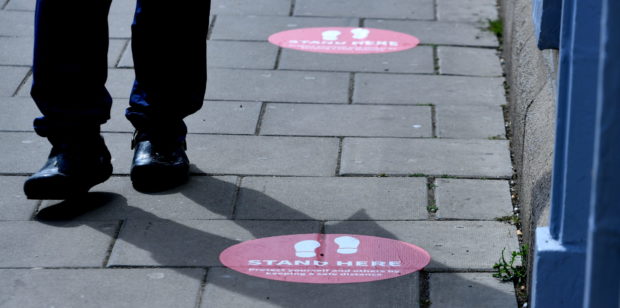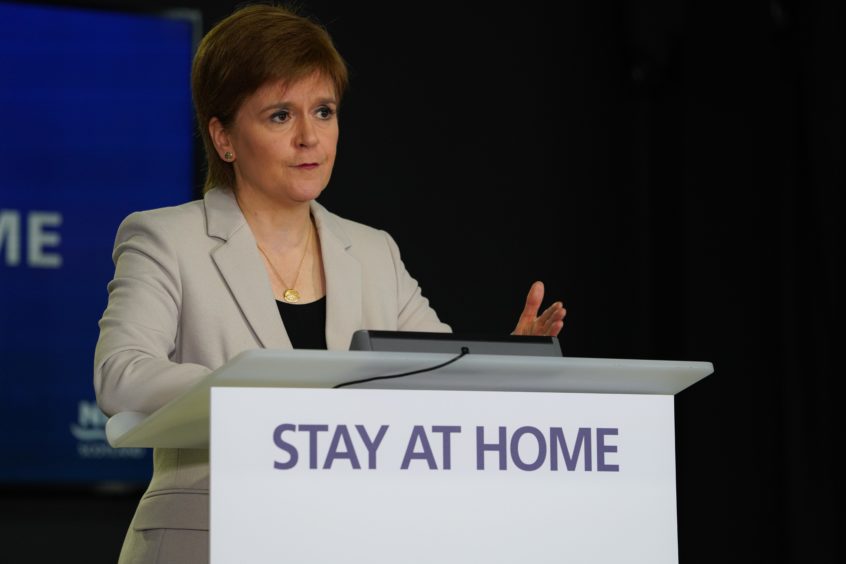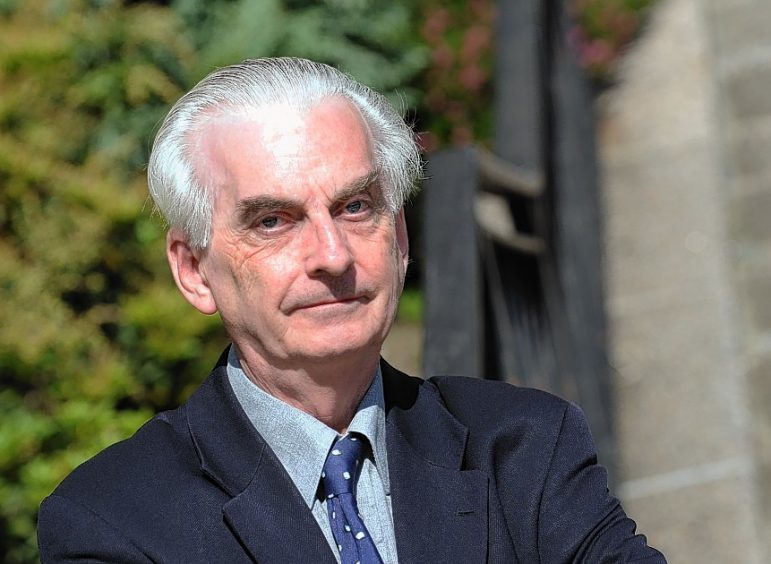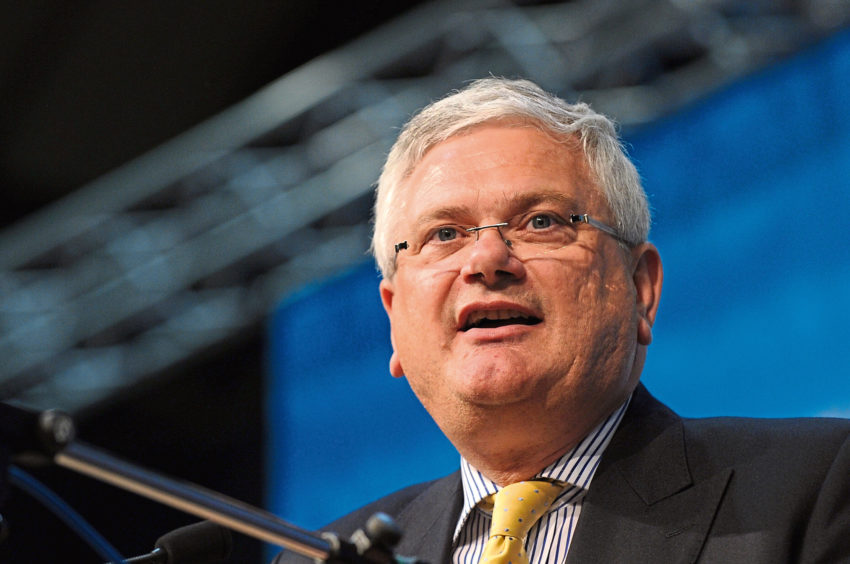Moving too soon to reduce physical distancing measures from two metres to one could be “catastrophic”, according to one professor.
A debate has been raging in recent days as to whether the UK should follow the advice of the World Health Organisation, and countries including France, to move to staying one metre apart rather than following the current public health advice of staying two metres away.
It comes as Prime Minister Boris Johnson said that he hopes to be able to reduce the distance to boost the hospitality industry and make it easier to travel on public transport.
Speaking during her daily briefing on Thursday, First Minister Nicola Sturgeon was clear the advice she has received is there should be no change to the two-metre guidance but added she would continue to listen to the advice “if that changes”.
Her stance is backed by Professor Andrew Watterson, of the occupational and environmental health research group at Stirling University, who said while there is “limited science” to support the two-metre distance, there is “far less” to support moving to just one.
The public health expert pointed to a recent study partly-funded by the World Health Organisation (WHO) and published in the Lancet, which found that reducing physical distancing advice from two metres to one metre could double the risk of coronavirus infection.
The study, which has been referenced by the First Minister in both the Scottish Parliament and during her daily media briefings, found that keeping a distance of more than one metre from other people reduced the risk of infection to 3%, compared with 13% if standing within a metre.
The UK Government’s chief scientific advisers have expressed caution over the move and the First Minister has confirmed she does not plan to change the current two-metre recommendation.
Prof Watterson said this is “good advice” and has “more of a science base” than those who are advocating lowering the distance to one.
He added: “When you look at who has been making the arguments (in favour of moving to one metre), it’s actually economists, sociologists and policy people, they’re not, in fact, the scientific community.
“It is incredibly damaging to our economy but what has been damaging to the economy is the pandemic so what you don’t want is the second wave or big clusters in places that close down businesses.
“That is why adopting the precautionary principle in a public health context is very wise.
“Loosening too soon could be catastrophic and we are actually already seeing signs of that in the US and India.”
A statement by the World Health Organisation said the guidance on physical distancing is based on a review of 44 comparative studies, with the findings supporting their recommendation that people should physically distance by at least one metre.
Prof Watterson said colleagues of his are currently involved in discussions with the WHO to establish on what basis the organisation advised one metre but claims they have “not had a very satisfactory answer”.
He added: “My view would be the science is pretty strong. The WHO has been good in some instances, such as testing, but seems to have been a little hazy and a little loose in terms of not being able to document arguments for reducing social distancing to one metre.”
Loosening too soon could be catastrophic and we are actually already seeing signs of that in the US and India.”
Professor Andrew Watterson, Stirling University
According to reports, Boris Johnson wants to end the two-metre social distancing guidance by September to allow schools to fully reopen at the new academic year.
Asked at Wednesday’s Downing Street briefing whether the restriction may be changed to one metre, Sir Patrick Vallance, the government’s chief scientific adviser, said: “It is not a rule, it is not a scientific rule – it is a risk-based assessment on when risk reduces.”
Speaking during her daily briefing, First Minister Nicola Sturgeon said the two-metre guidance should stop being seen as an “ideological position”.
She added: “These are difficult judgements. We know the risk of transmission at two metres is less than at one metre.
“I have to come to a judgement and we have to understand the trade-offs.
“I want to get the economy going as quickly as possible and I want to get it going in a way that is as close to normal as possible as quickly as possible.
“But if the consequence of doing so is the virus starts to spread again and people start dying and we have to lockdown again, that is not helping the businesses arguing for a change to this.
“The advice that has been given to me right now is: we shouldn’t change the two metres.”
But if the consequence of doing so is the virus starts to spread again and people start dying and we have to lockdown again, that is not helping the businesses arguing for a change to this.”
First Minister Nicola Sturgeon.
Meanwhile, Professor Hugh Pennington, emeritus professor of bacteriology at Aberdeen University, said there is “no doubt” that two metres is safer than one metre but adds there is “no simple answer” on the issue.
He added: “When people ask the experts they say it’s complicated because you also have to take into account the actual level of infection that’s out there in the community.
“Doing that calculation is difficult because we don’t have really accurate figures about infection in the community.
“We just don’t have the accurate number of cases out there that we would like to have to be able to say ‘yes, it is now safe to go from two to one’ or even in a restaurant to go back to where you were before when you didn’t worry about distancing at all.”
However, the microbiologist claims “many businesses” will cease to operate if the guidance remains at two metres, adding that the first minister faces a difficult balancing act.
He said: “Nicola Sturgeon has got to balance the survival of tourism and the hospitality industry against, perhaps, a few infections happening.
“I don’t think there would be a lot of infections but they might be in people who are vulnerable and might die as a consequence.
“It’s a very difficult balancing act to do but sooner or later a decision will have to be made.
“They’ll have to have a review once the level of infection across Scotland as a whole has got to a point where you can say go to one metre but what that level is, I don’t know what their thinking is on that.”
North-east MSP Mike Rumbles is among those calling on the Scottish Government to review the guidance to allow businesses across the region to get back into operation.
He said: “Many businesses would benefit if the WHO science was followed rather than the UK making up our own social distancing rules.
“The WHO says that a minimum of one-metre social distancing is safe, it doesn’t say a minimum of two metres.
“I am calling for the Scottish Government to review the rules as we move out of lockdown so that many more businesses can operate safely.”
A spokesman for the Scottish Conservatives said it is “essential” that the question of appropriate social distancing is now addressed.
He added: “With a timeline now emerging for the reopening of key sectors of the Scottish economy, including our vital tourism sector, it is important that businesses have as much certainty as possible, as early as possible, about the rules they will need to follow.
“The Scottish Government should now publish all advice and evidence it has received on the existing two-metre rule, so that a fully informed discussion can be had on this matter.”




